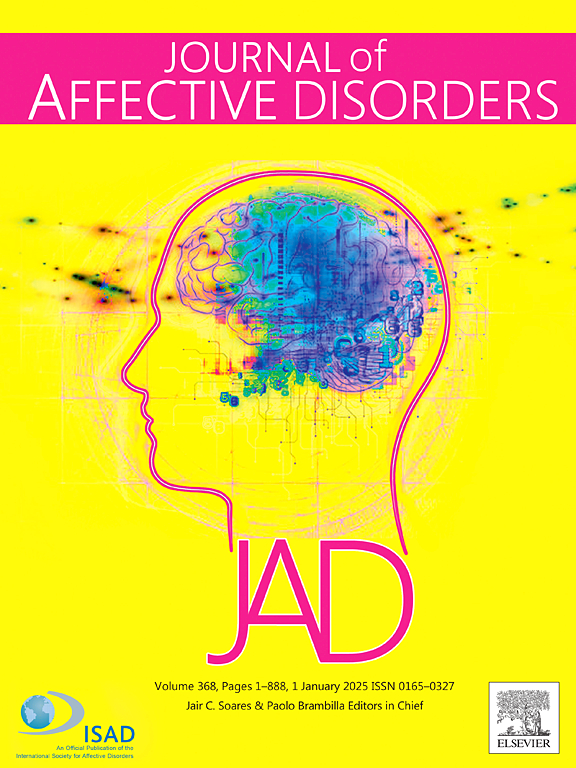Economic evaluation of subcutaneous ketamine injections for treatment resistant depression: A randomised, double-blind, active-controlled trial – The KADS study
IF 4.9
2区 医学
Q1 CLINICAL NEUROLOGY
引用次数: 0
Abstract
Background
Ketamine is effective for treatment resistant depression (TRD); but cost-effectiveness evidence remains limited.
Aims
To evaluate the cost-effectiveness of subcutaneous ketamine for TRD from health sector and societal perspectives.
Methods
A cost-utility analysis alongside the KADS randomised controlled trial (RCT) involved 174 participants receiving ketamine or midazolam (active control) twice weekly for 4 weeks. Healthcare resource use, transportation, carer time and lost productivity data were collected via self-reported questionnaire at baseline, end of RCT (week 4) and RCT 4-week follow-up (week 8). Quality-adjusted life years (QALYs) were calculated using AQoL-8D utility values. Initial dosing was fixed (cohort 1) and changed to response-guided dosing (cohort 2). Base-case 1 included control arm treatment costs; base-case 2 excluded these costs.
Results
At end of RCT, cohort 2 utility values were significantly higher for ketamine than the control treatment (0.435 vs. 0.352; p < 0.05). Health sector incremental cost-effectiveness ratios (ICERs) in base-case 1 indicated ketamine was dominant (less costly, more effective) with probabilities of falling below $50,000/QALY of 89 % (end of RCT) and 91 % (total across 8-weeks). Societal perspective probabilities were lower (30–32 %). In base-case 2, ketamine was not cost-effective (ICERs: $251,250/QALY at end of RCT; $108,500/QALY across 8-weeks), with minimal probabilities (0–5 %) of falling below $50,000/QALY.
Conclusions
The initial four-week ketamine treatment phase appeared cost-effective from a health sector perspective when including control arm costs, although societal perspective results were less favourable. Excluding control treatment costs highlighted substantial uncertainty, emphasising the importance of selecting an appropriate comparator for an economic evaluation.
皮下注射氯胺酮治疗难治性抑郁症的经济评价:一项随机、双盲、主动对照试验- KADS研究。
背景:氯胺酮是治疗难治性抑郁症(TRD)的有效药物;但成本效益的证据仍然有限。目的:从卫生部门和社会角度评价皮下氯胺酮治疗TRD的成本效益。方法:对174名接受氯胺酮或咪达唑仑(主动对照)治疗的参与者进行成本-效用分析,每周两次,持续4 周。在基线、RCT结束(第4周)和RCT 4周随访(第8周)时,通过自我报告问卷收集医疗资源使用、交通、护理时间和生产力损失数据。使用aql - 8d效用值计算质量调整生命年(QALYs)。初始剂量固定(队列1),改为反应导向剂量(队列2)。基本案例1包括对照臂治疗费用;基本情况2不包括这些费用。结果:在RCT结束时,队列2治疗氯胺酮的效用值显著高于对照组(0.435 vs. 0.352;p 结论:从卫生部门的角度来看,包括对照组费用在内,最初的四周氯胺酮治疗阶段似乎具有成本效益,尽管从社会角度来看结果不太有利。排除控制治疗费用突出了很大的不确定性,强调了选择适当比较国进行经济评价的重要性。
本文章由计算机程序翻译,如有差异,请以英文原文为准。
求助全文
约1分钟内获得全文
求助全文
来源期刊

Journal of affective disorders
医学-精神病学
CiteScore
10.90
自引率
6.10%
发文量
1319
审稿时长
9.3 weeks
期刊介绍:
The Journal of Affective Disorders publishes papers concerned with affective disorders in the widest sense: depression, mania, mood spectrum, emotions and personality, anxiety and stress. It is interdisciplinary and aims to bring together different approaches for a diverse readership. Top quality papers will be accepted dealing with any aspect of affective disorders, including neuroimaging, cognitive neurosciences, genetics, molecular biology, experimental and clinical neurosciences, pharmacology, neuroimmunoendocrinology, intervention and treatment trials.
 求助内容:
求助内容: 应助结果提醒方式:
应助结果提醒方式:


